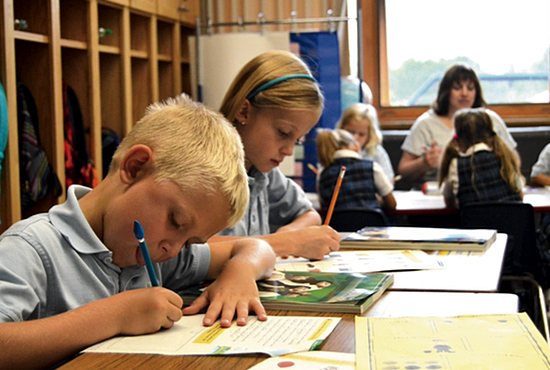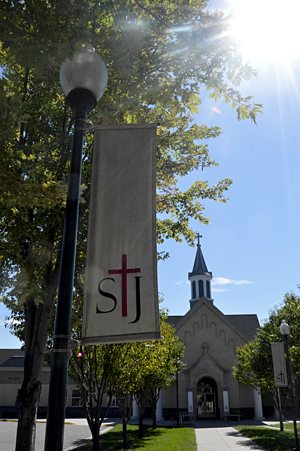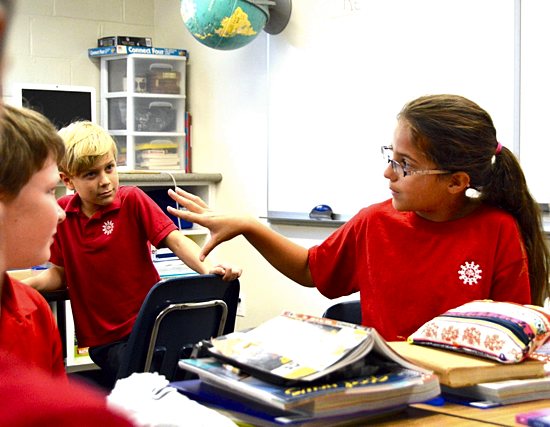
You won’t find your way to some Catholic elementary schools in the Archdiocese of St. Paul and Minneapolis by looking at the side of the official Minnesota State Highway Map that shows just the metro area.
Some Catholic schools are so far from the downtowns of the Twin Cities they aren’t even within that map’s scope.
The adjective “rural” fits some of them.Before this year’s harvest, soybeans up to your knees lined one side of Hwy. 13 and on the other, record-yielding corn grew over your head on the way to Most Holy Redeemer School in Montgomery, which enrolls 87 students more than 50 miles southwest of the State Capitol.
West of Minneapolis, a hand-painted sign promoting St. Joseph Catholic School in Waconia sits on the side of County 10 south of town. A farm and cornfield are the backdrop, but that’s misleading. Waconia might better be described as an exurban Catholic school, one in a once-rural town becoming more suburban as development sprawls west down Hwy. 5.
Others are better described as being in small towns or outer-ring suburbs.
There are currently 79 Catholic elementary schools in the archdiocese. In the past 10 years, decreasing enrollment and financial issues have forced the mergers of some urban and suburban schools, but of the 11 schools that have closed since 2005, five have been in the outskirts of the archdiocese in the towns of Loretto, Cologne, Red Wing, New Trier and Hampton.
To take the temperature of Catholic education in the areas dozens of miles outside the I-494-694 loop as the 2015-16 school year got underway, The Catholic Spirit visited classrooms and interviewed principals, teachers and parents.
Many strengths
What came to light were common positive attributes — faculties deeply committed to integrating the Catholic faith into all they teach, for one thing — and challenges, especially marketing and increasing enrollment.
Among the strengths observed at Catholic schools on the geographic edges of the archdiocese:
- Robust emphasis on their faith-based foundation. Teachers and administrators know why their Catholic school exists, sacrifice to work there and value the opportunity to serve in a Catholic setting.
- Test scores of Catholic school students at schools in the outlying areas continue to match or exceed the scores of their public school peers.
- Creative principals are trying a variety of strategies to boost enrollment.
- Competitive educational tools and methods are the norm, not the exception. STEM (science, technology, engineering and math) curricula and variations that add religion and the arts are prevalent.“Our schools are really competing in the STEM area,” noted Gary Wilmer, a veteran Catholic school administrator who is assistant director for governance and human resources for the Office for the Mission of Catholic Education. “As the price of technology goes down, it’s not cheap, but many of our schools are taking full advantage of foundation grants to upgrade their technology.”
- More and more, schools are upgrading their websites and using social media to push out information. St. Joseph in Waconia, in particular, has a superb video to explain its Catholic STEM program.

Opportunities for growth
Challenges include finances. While some schools are on stable footing, others have faced the wolf at the door.
“The main issue here is that people weren’t sure the school was going to remain open,” said Mike Gerard, principal of Mary, Queen of Peace School in Rogers, noting that some parents hesitated to enroll their children.
Other challenges:
• Recruiting and retaining good staff. Salaries for principals and teachers in most public school districts are 25 percent higher than at their school, several Catholic school principals said, and others agreed that was probably true for their area as well.
• Turnover in leadership. One principal was the fifth the school has had in a 10-year span. Another said a big challenge was “the change-over of priests, especially [the assigning of] ones who are not as familiar with the rural setting and not familiar with Catholic schools.”
• Affording technology. “It’s always changing, it always needs updating, and it’s very expensive,” explained Alissa Louwagie, principal of St. Francis Xavier School in Buffalo. At another school, computers were 20 to 25 years old; at still another, the computers that were there just didn’t work. One principal said many grants are aimed at urban schools, and poverty is often overlooked.
• Marketing and enrollment. Competition from some public school districts is strong, and the cost of tuition can be a deterrent for families. Catholic parish schools typically spend relatively few dollars to market their schools, relying on word of mouth to attract parents of potential students.
The cost of Catholic education is a factor for most families, particularly when public schools are free, and principals at every school The Catholic Spirit visited are aware that many parents sacrifice for their children to have a Catholic education.

St. Michael School in St. Michael. Bob Zyskowski/The Catholic Spirit
Several principals expressed gratitude to the Richard M. Schulze Family Foundation for grants that have enabled them to offer scholarships to families in need and to pay for updated technology and other school needs.
Addressing the challenges Catholic schools across the archdiocese face is one of the core focuses of the Catholic Schools Center of Excellence, established this spring.
Gail Dorn, president of CSCOE, said the organization has already begun assisting schools to obtain funding for some of their technology and marketing needs.
“Our focus is on building excellence and building enrollment,” Dorn explained. “We ask what their needs are, and we try to help them achieve their goals.”
Assessments of all Catholic schools in the archdiocese have shown that there is no one-size-fits-all solution to the needs schools have, and CSCOE takes a customized approach with each.
“For some the focus is on the pipeline [of students] — early childhood and pre-K as feeders to boost enrollment,” Dorn said.
In many cases CSCOE is sharing information, helping principals assess data and sharing best practices, Dorn said.
This year, CSCOE is undertaking a technology audit of all Catholic schools in the archdiocese, she added.
Mona Kramer has seen four of her children graduate from St. Michael School in St. Michael and still has a daughter, Maggie, in fourth grade. She said she and her husband are “beyond pleased” with the school. A faith-based education was important to them and the academic program “has made [our children] more than prepared for the next step” in high school, Kramer said.
She didn’t, however, approach the cost of Catholic education from the point of view of sacrifice.
“It’s not a sacrifice,” Kramer said. “We make choices. You change your philosophy of spending when you decide to send your children to Catholic school. You change your spending habits.”



